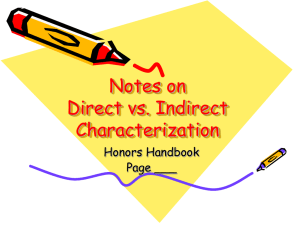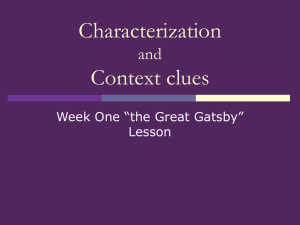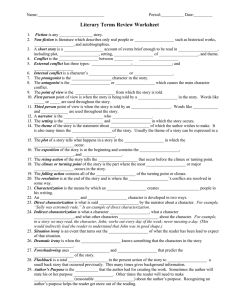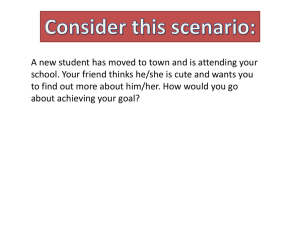Setting
advertisement
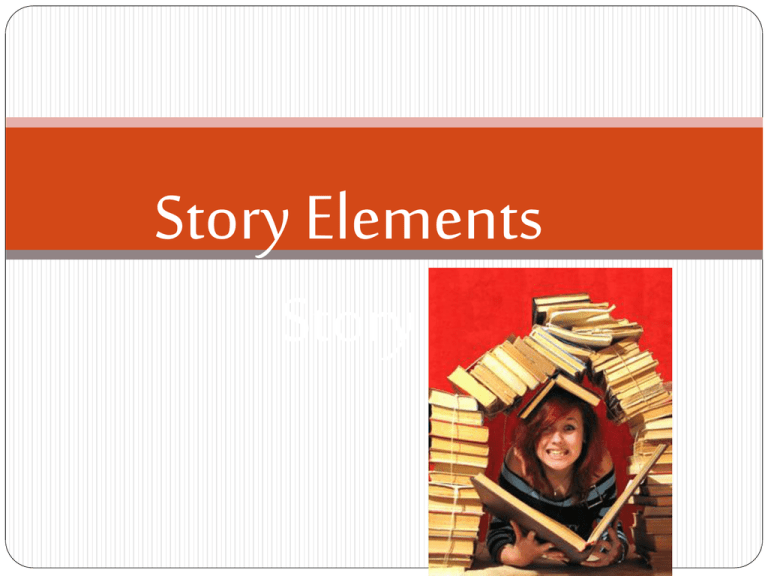
Story Elements Story What do we need to make a story? Setting – The time and place a story takes place. Characters – the people, animals or creatures in a story. Plot – the series of events that make up a story. Conflict – a problem or struggle between two people, things or ideas. Setting What is setting? • The setting describes where and when the story takes place. • It helps build background and create images in the mind. • It helps set the tone or mood of the story. Aspects of a story’s setting 1. Place – geographical location. Where does the action of the story take place? Aspects of a story’s setting 2. Time – When is the story taking place? (Ex: in ancient Egypt, in the 1960s, during present day) Aspects of a story’s setting 3. Weather conditions – Is it rainy, sunny, stormy, etc? Aspects of a story’s setting 4. Social conditions – What is the daily life of the character like? The story may contain local color (writing that focuses on the speech, dress, mannerisms, or customs of a particular place) Aspects of a story’s setting 5. Mood or atmosphere – What feeling is created at the beginning of the story? Bright and cheerful? Dark and frightening? How is setting created? • A good setting helps the reader visualize the places in the story. • A good author includes descriptions of the setting using the five senses… • • • • • SIGHT SMELL TASTE FEEL SOUND Take a Look…Which is better? The castle was beside the water. OR… The waves crashed loudly against the shoreline. The fog lifted lightly and the medieval castle came into view. It was a beautiful site! The fog brushed my face and I could smell the smoke from the fire in the distance and taste the sea salt on my lips. Your Turn… • On the next slide, there is a picture of a setting. • In your own words, write a detailed description of the setting in this picture. • What do you see, smell, taste, touch, and feel? Use many adjectives! When I walk onto the beach I…. see smell hear taste feel CHARACTERS EVERY STORY NEEDS CHARACTERS… Animals People Or Creatures THE PROTAGONIST IS THE “GOOD GUY” AND THE MAIN CHARACTER IN THE STORY THE ANTAGONIST IS THE “BAD GUY” OR FORCE CHARACTERIZATION Characterization is the way in which an author shows the personality of a character •Writers use characterization to make characters “come to life.” CHARACTERIZATION There are two types of characterization. Direct Characterization: when a writer tells you directly about a character. Ex.: Sidney Crosby is very competitive. CHARACTERIZATION Indirect Characterization: when a writer gives you clues about a character through writing Ex: In the final two minutes, Crosby gathered his teammates and laid out his plan. He looked at them and said, “We are going to win this one. No excuses.” He then pounded their chest pads and skated onto the ice. INDIRECT CHARACTERIZATION In indirect characterization, there are five ways an author gives the reader clues about a character’s personality. 1. What the character DOES INDIRECT CHARACTERIZATION In indirect characterization, there are five ways an author gives the reader clues about a character’s personality. 2. What the character SAYS INDIRECT CHARACTERIZATION In indirect characterization, there are five ways an author gives the reader clues about a character’s personality. 3. What the character LOOKS LIKE INDIRECT CHARACTERIZATION In indirect characterization, there are five ways an author gives the reader clues about a character’s personality. 4. What the character THINKS INDIRECT CHARACTERIZATION In indirect characterization, there are five ways an author gives the reader clues about a character’s personality. 5. How other characters react to him or her CHARACTER TRAITS WE USE CHARACTER TRAITS TO DESCRIBE SPECIFIC QUALITIES OF A CHARACTER •Honest •Light-hearted •Leader •Expert •Brave •Conceited •Mischievous •Demanding •Thoughtful •Keen •Happy •Disagreeable •Simple •Fancy •Plain •Excited •Studious •Inventive •Creative •Thrilling •Independent •Intelligent •Compassionate •Gentle •Proud •Wild •Messy •Neat •Joyful •Strong •Bright •Courageous •Serious •Funny •Humorous •Sad •Poor •Rich •Tall •Dark •Light •Handsome •Pretty •Ugly •Selfish •Unselfish •Self-confident •Respectful •Considerate •Imaginative •Busy •Patriotic •Fun-loving •Popular •Successful •Responsible •Lazy •Dreamer •Helpful •Simpleminded •Humble •Friendly •Short •Adventurous •Hard-working •Timid •Shy •Bold •Daring •Dainty •Pitiful •Cooperative •Lovable •Prim •Proper •Ambitious •Able •Quiet •Curious •Reserved •Pleasing •Bossy •Witty •Fighter •Tireless •Energetic •Cheerful •Smart •Impulsive •Loyal YOUR TURN… Think of a character from a book, movie, or TV show. Name the character Give the character one trait Give two examples why that trait fits that character Remember…what does the character do, what does he say, what does he think, how does he look, and how do others react to him? Plot Plot is the… Organized sequence of events that make up a story. • What happens to the characters in the story – the events and actions within a story and how they link together. Plot Diagram 2 1 3 4 5 1. Exposition • • • • Usually near the beginning of a story. Characters are introduced. We learn about the setting. Most importantly, we are introduced to the main conflict (main problem). 2. Rising Action • Develops the conflict(s) with details. • Builds interest or suspense. 3. Climax • Turning point of the story—the most exciting part! • Main character comes face to face with a conflict. • Most of the time, the main character will change in some way. 4. Falling Action • All of the action after the climax 5. Resolution • Story comes to a reasonable ending • Ties together loose ends, sometimes telling us the theme. Special Techniques of Plot… Suspense- excitement or tension Flashback- interrupts the normal sequence of events to tell about something that happened in the past Surprise Ending- conclusion that reader does not expect And…Foreshadowing… A hint about what will happen next is called foreshadowing In Jaws, what hear music…and this music is foreshadowing. Someone is about to be eaten! Your Turn… • Let’s put these scenes from Cinderella into a plot diagram. Cinderella’s fairy godmother grants her wishes, and she goes to the ball. She meets the prince! Cinderella marries the prince, and they live happily ever after. Cinderella’s father dies and she has to live with her stepmother and stepsisters. Cinderella has the other glass slipper! She tries it on, and it fits! The prince’s advisors tell the prince that Cinderella had the glass slipper and it fit. Conflict is the “battle” between two forces. Without conflict, there is no PLOT Conflict isn’t always bad..sometimes it helps to create change. 1. Character vs. Character: A character battles another character 2. Character vs. Nature: A character battles against nature 3. Character vs. Society: A character has a conflict with a larger group, such as a community, culture or society 4. Character vs. Self: a character struggles with internal conflicts Write down the CONFLICT or conflicts in the following stories, nursery rhymes, or movies: Cinderella The Three Little Pigs Into the Storm Frozen Then, can you come up with examples for these conflicts: Character vs. Character Character vs. Nature Character vs. Self? Point of view is the vantage point from which the story is told. This author’s choice of narrator determines the amount of information a reader will receive. 1. First Person: The narrator is a character in the story who observes and reports the action. • Ex: “I saw a purple horse.” “We went to the game.” “Our team won the tournament.” I will tell you my story 2. Third person: The narrator is an outsider; not a character in the story. Ex.: She picked up the glass of water and threw it on John. Justin Bieber accepted his award then danced off the stage. Third Person Limited: the narrator focuses on the thoughts and feelings of only one character. The reader observes the action through the eyes and feelings of just that character. Third Person Omniscient: An outsider who knows everything about all characters (even their problems and their feelings!) tells the story. “God-like” Write this in first person point of view: 1. She sat down on the couch, opened her favorite magazine, and read a really funny story. It made her laugh hysterically! What point of view is this an example of? 2. John rushed through his homework so that he could take a walk with Kara. He thought Kara was perfect—kind, intelligent, and always willing to play kickball when they needed another person. He wanted to ask her to be his girlfriend, but he was too scared. He hated how shy he was. Theme: The message about life or human nature that is revealed in a story. In other words… Theme is the author’s message. What is the author trying to say through his writing? In most stories, the theme is not stated directly. Instead, it is revealed to us through the characters’ experiences. Writers often express theme through what their characters learn. • Does the main character change? • Does a character realize something he or she did not know before? • If you can answer these questions…this might be the theme! Keep the following guidelines in mind when you want to find and state the theme of a work. The theme is not the same thing as the subject. • The subject is simply the topic. It can be stated in a single word, such as loyalty. • The theme makes some revelation about the subject and should be expressed in a sentence: • Ex: Loyalty to a leader is not always noble. Money can’t buy happiness. Don’t judge people based on the surface. Quick Check Stories Match these familiar stories to the appropriate theme. Beauty and the Beast The Three Little Pigs The Ugly Duckling A It pays to work hard and plan ahead. B Appearances can be deceiving. Your Turn… Once there was a mean little boy who lived in a small village. This mean little boy loved to mess with people, so one day he ran up to a sheep herder and shouted, “WOLF! WOLF! A wolf is attacking the town!” The sheep herder grabbed his staff and ran to defend the town, but realized he had been fooled when the boy started pointing and laughing at him. “Ha ha! I made you jump,” said the boy. Then the boy ran up to a farmer and shouted, “WOLF! WOLF! A wolf is attacking the town!” The farmer grabbed his pitchfork and ran to defend the town, but when the boy started pointing and laughing at him, he realized he had been tricked. As the boy went back to his family’s farm laughing about the funny trick he played, he saw a real wolf in his father’s chicken coop. As the wolf ate all of his father’s chickens, the boy screamed over and over again, “WOLF! WOLF! Please help us!” But nobody came to help him. Does the character realize something he or she didn’t know before? What lesson or message is the author trying to show through this writing? Don’t ask for help unless you really need it. Don’t play tricks on the people around you. Jenny Puchovier was so excited. She had a pack of Starburst in her lunch and she had been looking forward to eating them all morning. Lunch finally came and Jenny sat down to eat her Starbursts when Judy sat next to her. “Let me get the pink ones,” said Judy. Jenny liked the pink ones best, but she thought Judy was funny and Jenny wanted Judy to like her, so Jenny gave Judy all of her pink Starbursts. Before Jenny was done giving Judy the pink ones, Carrie sat on the other side of Jenny. “Let me get the red and the orange ones, Jenny. Remember when I gave you that Snickers?” Jenny didn’t remember that, though she did remember when Carrie ate a whole Snickers in front of her. Still, Jenny thought Carrie was cool, so she gave her the red and the orange Starbursts. Judy and Carrie then took the Starbursts and left the table, leaving Jenny to eat by herself. Does the character realize something he or she didn’t know before? What lesson or message is the author trying to show through this writing? You can’t buy friends. Be careful of people who want what you have. Not everybody is your friend.

